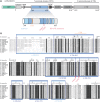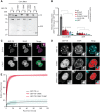DNMT1 mutations found in HSANIE patients affect interaction with UHRF1 and neuronal differentiation
- PMID: 28334952
- PMCID: PMC5393148
- DOI: 10.1093/hmg/ddx057
DNMT1 mutations found in HSANIE patients affect interaction with UHRF1 and neuronal differentiation
Abstract
DNMT1 is recruited to substrate sites by PCNA and UHRF1 to maintain DNA methylation after replication. The cell cycle dependent recruitment of DNMT1 is mediated by the PCNA-binding domain (PBD) and the targeting sequence (TS) within the N-terminal regulatory domain. The TS domain was found to be mutated in patients suffering from hereditary sensory and autonomic neuropathies with dementia and hearing loss (HSANIE) and autosomal dominant cerebellar ataxia deafness and narcolepsy (ADCA-DN) and is associated with global hypomethylation and site specific hypermethylation. With functional complementation assays in mouse embryonic stem cells, we showed that DNMT1 mutations P496Y and Y500C identified in HSANIE patients not only impair DNMT1 heterochromatin association, but also UHRF1 interaction resulting in hypomethylation. Similar DNA methylation defects were observed when DNMT1 interacting domains in UHRF1, the UBL and the SRA domain, were deleted. With cell-based assays, we could show that HSANIE associated mutations perturb DNMT1 heterochromatin association and catalytic complex formation at methylation sites and decrease protein stability in late S and G2 phase. To investigate the neuronal phenotype of HSANIE mutations, we performed DNMT1 rescue assays and could show that cells expressing mutated DNMT1 were prone to apoptosis and failed to differentiate into neuronal lineage. Our results provide insights into the molecular basis of DNMT1 dysfunction in HSANIE patients and emphasize the importance of the TS domain in the regulation of DNA methylation in pluripotent and differentiating cells.
© The Author 2017. Published by Oxford University Press.
Figures






Similar articles
-
Coordinated Dialogue between UHRF1 and DNMT1 to Ensure Faithful Inheritance of Methylated DNA Patterns.Genes (Basel). 2019 Jan 18;10(1):65. doi: 10.3390/genes10010065. Genes (Basel). 2019. PMID: 30669400 Free PMC article. Review.
-
Aberrant signature methylome by DNMT1 hot spot mutation in hereditary sensory and autonomic neuropathy 1E.Epigenetics. 2014 Aug;9(8):1184-93. doi: 10.4161/epi.29676. Epub 2014 Jul 7. Epigenetics. 2014. PMID: 25033457 Free PMC article.
-
Mutations in DNMT1 cause hereditary sensory neuropathy with dementia and hearing loss.Nat Genet. 2011 Jun;43(6):595-600. doi: 10.1038/ng.830. Epub 2011 May 1. Nat Genet. 2011. PMID: 21532572 Free PMC article.
-
The Ubiquitin-like with PHD and Ring Finger Domains 1 (UHRF1)/DNA Methyltransferase 1 (DNMT1) Axis Is a Primary Regulator of Cell Senescence.J Biol Chem. 2017 Mar 3;292(9):3729-3739. doi: 10.1074/jbc.M116.750539. Epub 2017 Jan 18. J Biol Chem. 2017. PMID: 28100769 Free PMC article.
-
Recruitment of Dnmt1 roles of the SRA protein Np95 (Uhrf1) and other factors.Prog Mol Biol Transl Sci. 2011;101:289-310. doi: 10.1016/B978-0-12-387685-0.00008-1. Prog Mol Biol Transl Sci. 2011. PMID: 21507355 Review.
Cited by
-
dnmt1 function is required to maintain retinal stem cells within the ciliary marginal zone of the zebrafish eye.Sci Rep. 2020 Jul 9;10(1):11293. doi: 10.1038/s41598-020-68016-z. Sci Rep. 2020. PMID: 32647199 Free PMC article.
-
Human Hyperekplexic Mutations in Glycine Receptors Disinhibit the Brainstem by Hijacking GABAA Receptors.iScience. 2019 Sep 27;19:634-646. doi: 10.1016/j.isci.2019.08.018. Epub 2019 Aug 13. iScience. 2019. PMID: 31450193 Free PMC article.
-
Effect of Disease-Associated Germline Mutations on Structure Function Relationship of DNA Methyltransferases.Genes (Basel). 2019 May 14;10(5):369. doi: 10.3390/genes10050369. Genes (Basel). 2019. PMID: 31091831 Free PMC article. Review.
-
Activity-based CRISPR scanning uncovers allostery in DNA methylation maintenance machinery.Elife. 2023 Feb 10;12:e80640. doi: 10.7554/eLife.80640. Elife. 2023. PMID: 36762644 Free PMC article.
-
Coordinated Dialogue between UHRF1 and DNMT1 to Ensure Faithful Inheritance of Methylated DNA Patterns.Genes (Basel). 2019 Jan 18;10(1):65. doi: 10.3390/genes10010065. Genes (Basel). 2019. PMID: 30669400 Free PMC article. Review.
References
-
- Bird A. (2002) DNA methylation patterns and epigenetic memory. Genes Dev., 16, 6–21. - PubMed
-
- Goll M.G., Bestor T.H. (2005) Eukaryotic cytosine methyltransferases. Annu. Rev. Biochem., 74, 481–514. - PubMed
-
- Smith Z.D., Meissner A. (2013) DNA methylation: roles in mammalian development. Nat. Rev. Genet., 14, 204–220. - PubMed
MeSH terms
Substances
LinkOut - more resources
Full Text Sources
Other Literature Sources
Miscellaneous

